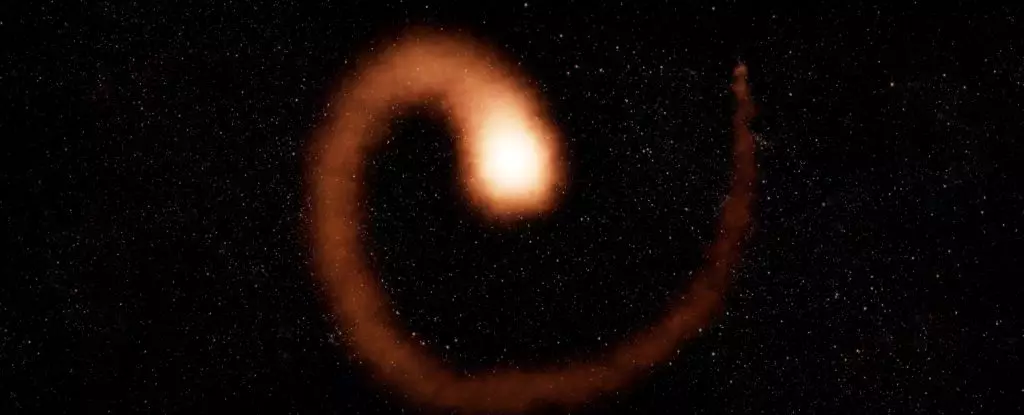Far beyond the confines of our solar system lies a stellar phenomenon that incites both awe and curiosity: the Wolf-Rayet star system WR 104. Unlike the familiar sun, these massive, luminous giants dwell at the end of their lifecycles, showcasing dramatic transformations that culminate in spectacular deaths. WR 104, also recognized as the Pinwheel Nebula, emerges as a striking example of this dance between life and death in the cosmic arena. Its unique morphology, shaped significantly by a binary companion, reveals much about the complex processes governing stellar evolution and mass loss.
The defining characteristic of a Wolf-Rayet star is its immense mass—approximately 13 times that of our sun—coupled with a rapid lifecycle that spans only about 7 million years. In such a brief existence, these cerulean beauties undergo massive losses in their outer layers, driven by fierce stellar winds fueled by radiation pressure. The result? An intricate interplay between two stars that morphs gaseous ejections into breathtaking spirals observable from great distances.
The Intriguing Interaction of Binary Stars
The recent research led by astronomer Grant Hill at the Keck Observatory has illuminated the interactions in the WR 104 system, offering fresh insights into its structure and potential risks to Earth. The significant twist in this narrative involves the orientation of the system’s binary stars. Contrary to earlier assumptions, the stars are not aligned in a way that would pose a gamma-ray threat to our planet upon the inevitable supernova. Instead, this tilting of the orbital plane—estimated to be 30 to 40 degrees—reveals that any catastrophic gamma-ray bursts released during the star’s final breaths would veer safely away from Earth.
The implications of this finding are far-reaching and reassuring, especially considering how common myths have nicknamed this stellar giant “the death star.” With previous assessments leaving a shadow of concern regarding its proximity—glass estimates range from 2,000 to 11,000 light-years—knowing that Earth is not in the line of cosmic fire removes an existential worry.
The Cosmic Dust Spiral: A Form of Art in the Universe
The visual allure of WR 104, punctuated by its swirling dust, extends beyond a mere spectacle. The dust’s spiral formation occurs through the gravitational dynamics between WR 104 and its massive OB companion, which has a mass nearly 30 times that of the sun. This interaction not only carves the dust into spirals but also generates heat and facilitates the emission of thermal radiation, enabling astronomers to detect the system through advanced infrared telescopes.
What renders this phenomenon all the more captivating is that the spiraled dust provides clues about both the nature of the star’s mass loss and the dynamics of their binary orbit. The continuous collision of stellar winds between the two stars acts as a furnace, heating the dust, which subsequently sparks intrigue across astrophysical communities.
A New Mystical Puzzle for Astronomers
While Hill’s research paves the way for understanding the mechanics of WR 104, it simultaneously unwraps an enigma. The positional misalignment between the spiral and the stars’ poles leads to more questions than answers. How could dust accumulate and spiral outward in a manner unrelated to the line of direct sight? This juxtaposition stands as a testament to the unpredictable nature of astronomy; even as we arm ourselves with knowledge, the universe retains its secrets.
This case serves as an invitation to embrace curiosity rather than seek closure. The wonder of exploring the cosmos resides in the discoveries that arise during our quests for understanding. It reflects the profound truth that each revelation tends to create new questions, revealing the universe as an endless series of mysteries waiting for exploration.
The detailed observational results from Keck remind us that even with advancements in technology and fiercely dedicated research, the cosmos holds the upper hand, often surprising us with its complexities. Each twist and turn in our celestial investigations adds depth to the narrative of the universe, stirring the innate human desire for knowledge and adventure.
As we delve deeper into the enigmatic behaviors of stars like WR 104, we ought to revel in the unexpected pathways of discovery. The universe, in its magnificent vastness, continues to weave stories that elucidate the intricate threads of life, death, and rebirth among the stars, reminding us of our humble yet grand place within this expansive celestial tapestry.


Leave a Reply